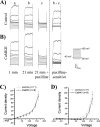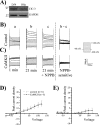Molecular interaction and functional regulation of ClC-3 by Ca2+/calmodulin-dependent protein kinase II (CaMKII) in human malignant glioma
- PMID: 20139089
- PMCID: PMC2856996
- DOI: 10.1074/jbc.M109.097675
Molecular interaction and functional regulation of ClC-3 by Ca2+/calmodulin-dependent protein kinase II (CaMKII) in human malignant glioma
Abstract
Glioblastoma multiforme is the most common and lethal primary brain cancer in adults. Tumor cells diffusely infiltrate the brain making focal surgical and radiation treatment challenging. The invasion of glioma cells into normal brain is facilitated by the activity of ion channels aiding dynamic regulation of cell volume. Recent studies have specifically implicated ClC-3, a voltage-gated chloride channel, in this process. However, the interaction between ClC-3 activity and cell movement is poorly understood. Here, we demonstrate that ClC-3 is highly expressed on the plasma membrane of human glioma cells where its activity is regulated through phosphorylation via Ca(2+)/calmodulin-dependent protein kinase II (CaMKII). Intracellular infusion of autoactivated CaMKII via patch pipette enhanced chloride currents 3-fold, and this regulation was inhibited by autocamtide-2 related inhibitory peptide, a CaMKII-specific inhibitor. CaMKII modulation of chloride currents was also lost upon stable small hairpin RNA knockdown of ClC-3 channels indicating a specific interaction of ClC-3 and CaMKII. In ClC-3-expressing cells, inhibition of CaMKII reduced glioma invasion to the same extent as direct inhibition of ClC-3. The importance of the molecular interaction of ClC-3 and CaMKII is further supported by our finding that CaMKII co-localizes and co-immunoprecipitates with ClC-3. ClC-3 and CaMKII also co-immunoprecipitate in tissue biopsies from patients diagnosed with grade IV glioblastoma. These tumor samples show 10-fold higher ClC-3 protein expression than nonmalignant brain. These data suggest that CaMKII is a molecular link translating intracellular calcium changes, which are intrinsically associated with glioma migration, to changes in ClC-3 conductance required for cell movement.
Figures








Similar articles
-
Identification of an N-terminal amino acid of the CLC-3 chloride channel critical in phosphorylation-dependent activation of a CaMKII-activated chloride current.J Physiol. 2004 Apr 15;556(Pt 2):353-68. doi: 10.1113/jphysiol.2003.058032. Epub 2004 Jan 30. J Physiol. 2004. PMID: 14754994 Free PMC article.
-
Role of Cl- channels in primary brain tumour.Cell Calcium. 2019 Jul;81:1-11. doi: 10.1016/j.ceca.2019.05.004. Epub 2019 May 14. Cell Calcium. 2019. PMID: 31129471 Review.
-
Bradykinin-induced chemotaxis of human gliomas requires the activation of KCa3.1 and ClC-3.J Neurosci. 2013 Jan 23;33(4):1427-40. doi: 10.1523/JNEUROSCI.3980-12.2013. J Neurosci. 2013. PMID: 23345219 Free PMC article.
-
Expression of voltage-gated chloride channels in human glioma cells.J Neurosci. 2003 Jul 2;23(13):5572-82. doi: 10.1523/JNEUROSCI.23-13-05572.2003. J Neurosci. 2003. PMID: 12843258 Free PMC article.
-
Mechanisms of cellular synchronization in the vascular wall. Mechanisms of vasomotion.Dan Med Bull. 2010 Oct;57(10):B4191. Dan Med Bull. 2010. PMID: 21040688 Review.
Cited by
-
ANO1 as a marker of oral squamous cell carcinoma and silencing ANO1 suppresses migration of human SCC-25 cells.Med Oral Patol Oral Cir Bucal. 2014 Jul 1;19(4):e313-9. doi: 10.4317/medoral.19076. Med Oral Patol Oral Cir Bucal. 2014. PMID: 24316695 Free PMC article.
-
Combating malignant astrocytes: Strategies mitigating tumor invasion.Neurosci Res. 2018 Jan;126:22-30. doi: 10.1016/j.neures.2017.09.010. Epub 2017 Oct 18. Neurosci Res. 2018. PMID: 29054465 Free PMC article. Review.
-
Integrated Proteogenomic Characterization across Major Histological Types of Pediatric Brain Cancer.Cell. 2020 Dec 23;183(7):1962-1985.e31. doi: 10.1016/j.cell.2020.10.044. Epub 2020 Nov 25. Cell. 2020. PMID: 33242424 Free PMC article.
-
Ion channels in glioblastoma.ISRN Neurol. 2011;2011:590249. doi: 10.5402/2011/590249. Epub 2011 Nov 29. ISRN Neurol. 2011. PMID: 22389824 Free PMC article.
-
The emerging role of CaMKII in cancer.Oncotarget. 2015 May 20;6(14):11725-34. doi: 10.18632/oncotarget.3955. Oncotarget. 2015. PMID: 25961153 Free PMC article. Review.
References
Publication types
MeSH terms
Substances
Grants and funding
LinkOut - more resources
Full Text Sources
Other Literature Sources
Medical
Miscellaneous

